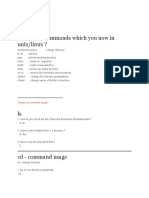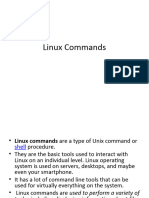0% found this document useful (0 votes)
29 views1 pageLinux Command Guide: Basics
The document provides explanations for basic Linux commands including ls, rmdir, cat, mkdir, pwd, cd, chgrp, and chmod. Each command is accompanied by a brief description and an example of its usage. These commands are essential for file and directory management in a Linux environment.
Uploaded by
Sonit MarwahCopyright
© © All Rights Reserved
We take content rights seriously. If you suspect this is your content, claim it here.
Available Formats
Download as DOCX, PDF, TXT or read online on Scribd
0% found this document useful (0 votes)
29 views1 pageLinux Command Guide: Basics
The document provides explanations for basic Linux commands including ls, rmdir, cat, mkdir, pwd, cd, chgrp, and chmod. Each command is accompanied by a brief description and an example of its usage. These commands are essential for file and directory management in a Linux environment.
Uploaded by
Sonit MarwahCopyright
© © All Rights Reserved
We take content rights seriously. If you suspect this is your content, claim it here.
Available Formats
Download as DOCX, PDF, TXT or read online on Scribd
/ 1

































































